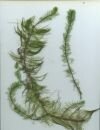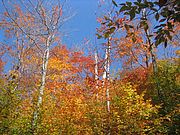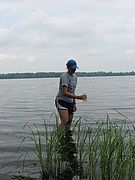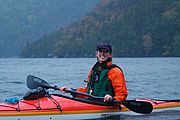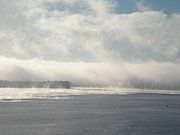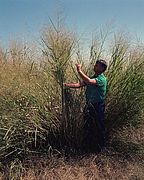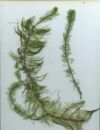Aquatic biologists at Vermont’s Agency of Natural Resources (ANR) found a population of the invasive plant, variable-leaved watermilfoil, in the southern end of Missisquoi Bay. Similar to the native whorled watermilfoil, a rare plant species in the state, the variable-leaved watermilfoil was confirmed by genetic analysis this week from samples pulled during a routine water chestnut search last month in the bay.
Though variable-leaved milfoil is known in the Adirondacks, Lake Champlain is only the second confirmation of the species in Vermont. The first was found in Halls Lake in Newbury in 2008. The invasive plant has also been found in Massachusetts, New Hampshire and Quebec waters.
Read...
Join LCC Staff Scientist Mike Winslow at the Lake Champlain Maritime Museum at Basin Harbor, Vermont on Thursday, October 1 for a provocative lake presentation. Learn about the forces that shape the lake, the creatures that call it home, the phenomena that add to its mystery, and what you can do to protect its future. The lecture is free and open to all so bring friends and family. Click here for directions to the Museum. Read...
While raking leaves and puttering around the house this fall, check the nearest stormdrain to be sure it too is free of debris. Plugged stormdrains prevent water from entering the storm sewer. Instead, the water starts eroding its own path to the nearest stream, and thus creates even more pollution.
One way to be sure the leaves you rake don’t contribute to clogging stormdrains is to compost them. Use your lawnmower to shred the leaves. If you have a bagger attachment the shredded leaves can be collected. Otherwise, use the blower on the motor to accumulate leaves. In either case the leaves make excellent mulch, or they can be added to a compost pile.
For more lake friendly tips, check out the Learn and Get Involved sections of our website and consider taking our Lake Protection Pledge. Read...
LCC wrapped up our 7th algae monitoring season just after Labor Day. Overall, although patchy blooms continued in Missisquoi Bay and sporadic blooms popped up in other parts of the lake, the frequency and intensity of blooms was lower this summer than in most past monitoring seasons. LCC staff identified a bloom in Kelly Bay at the far north end of the lake by the Rouses Point Bridge, an unusual place for such blooms. Though it is well known that high nutrient levels promote algae blooms, the exact triggers that determine when and where blooms occur are still unclear. The monitoring program is a key to efforts to identify toxic blooms, protect public health, and work for solutions.
Sincere thanks to the Lake Champlain Basin Program for funding support, our program partner Dr. Mary Watzin of the University of Vermont Rubenstein Ecosystem Science Laboratory and our faithful 2009 season monitors for their weekly wading into the water: Jennifer Bowman, Sally and Jim Brabham, Bryan Burke, Al Carpenter, Chris Case, Carson Cornbrooks, Deborah Diemand, Marc Eisenhower, David Greenough, Bill Magnus, Robert Martell, John McBride, Gary Molinski, Bob Murphy, Martha Perry, Larry and Jeanine Pratt, Mike Roach, Micah Rose, Julia Smith, Mark Sweeney, and Doug Ward.
Click here for an overview of the seasons monitoring results or go to www.lakechamplaincommittee.org/lcc-at-work/algae-in-lake/ and scroll to the bottom of the page. Read...
Foliage season, bird migrations and the serenity of a near empty lake all beckon the fall paddler. It can be a wonderful time to be on the water – if you’re well prepared. The cooler fall temperatures require a wet suit or dry suit. Any time the combined air and water temperatures are less than 120 degrees F, you should wear this extra gear under your Personal Flotation Device (PFD). You’ll also need lots of fuel to maintain your core temperature and reinvigorate tired muscles so be sure to bring lots of water and carbohydrate-rich snacks with you. Be cautious about heading out and make sure you, your boat and your group are properly equipped:
- Plan your trip ahead of time and make sure it matches the mental and physical skill set of your entire party.
- Leave your itinerary with a responsible onshore contact.
- Be aware of the wind, water and weather conditions before you depart.
- Bring a weather radio or VHF with you, check the weather forecast repeatedly, and adjust your travel plans accordingly.
- Always wear a Personal Flotation Device (PFD). Nine out of ten drownings occur in inland waters, most within a few feet of safety. Most of the victims owned PFDs but died without them. A properly fitted, buoyant PFD can save your life, only if you wear it.
- Wear a wetsuit or drysuit with an insulating layer and a hat that stays put. Dress for the season in layers of synthetic fabric to prevent getting overheated and chilled from perspiration or water.
- Pack extra dry clothing in a sealed bag.
- Test your gear in advance in a controlled cold water environment to learn how much protection it provides.
- Paddle near to shore and near others who can help you in the event of capsize.
- Make sure you have the skills to travel to and from shore and shelter.
- Ensure that everyone in your paddling party knows the signs and symptoms of hypothermia before you set out.
- Stay aware of all boat traffic.
- Fuel your body with high carbohydrate foods and lots of water.
We love to hear about our members’ outings! Please send pictures and tales from the water to: lcc@ lakechamplaincommittee.org. Read...
Throughout cold autumn evenings, the layer of air closest to the Lake Champlain’s water accumulates moisture and warmth. The moisture condenses and a thick steam fog forms with colder air masses generating thicker fogs. As the strengthening sun continues to warm the air, wisps of cloud flow upward, revealing the air’s convection currents. A layer of fluffy clouds hovers, seemingly suspended between the water and the otherwise azure blue sky. These clouds mark the border between the lake-warmed water and the cold air mass above. Eventually, the day’s sun warms all the air and the fog burns off. Click on the title to learn how steam fog played a key role in a pivotal Revolutionary War battle. Read...
The future will not look like the past. Such is true for the lake and the landscape. Rather than trying to recreate some hypothetical past utopia, we need to work towards a mutually desirable future state that is better than what we have. Agriculture may present the most significant opportunity today for envisioning and moving toward a desirable future state. Currently, agriculture in the Lake Champlain Basin is dominated by dairy production, but that may not be true in the future.
The dairy industry presents inevitable challenges to water quality. Cows produce manure which is high in phosphorus and bacteria. Cows, at least during the winter and on larger farms, eat corn, an annual crop that leaves much of the soil exposed and susceptible to erosion. Corn and other crops used to feed cows require inputs of additional phosphorus fertilizer which is a pollutant when it gets to the lake. Cows that are pastured instead of eating corn have a tendency to trample vegetation in their search for drinking water, directly contributing to erosion. All of these challenges can be managed and minimized, but they can not be eliminated.
Read...
Variable leaved-milfoil, a new invasive species in Lake Champlain, has been confirmed in Missisquoi Bay. Variable-leaved milfoil is closely related to Eurasian watermilfoil which already infests much of the lake. Click the headline for more information. Read...

